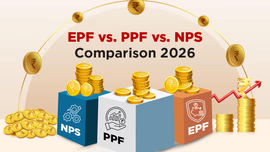Beware of Loan Scams in India: How Fraudsters Trick You and How to Stay Safe

The continuous growth in the number of digital banking and lending platforms has also resulted in the rise of loan fraud and scams. Fraudsters are becoming increasingly smart and using new and advanced methods such as fake websites, deepfake voice calls, phishing, etc., for scams. Today, it has become important to learn about these loan frauds and scam methods by understanding their warning signs. This article will help you spot loan fraud and also give you tips to protect yourself from such scams.
Table of Contents
- Loan Fraud and Scams in India
- Types of Loan Scams in India
- How to Check a Fake Loan?
- How to Prevent Loan Fraud?
- What to Do if Loan Fraud Happens?
Loan Fraud and Scams in India
In a loan fraud, criminals trick people into paying some kind of fees or share their personal information in order to get the loan amount, but the loan never gets credited. In most fraud cases, the urgent need for money and low interest rates are the most common causes for people to get involved in such scams.
Fake loan offers are sent through SMS, email, fraudulent applications, etc., to lure in victims. Cybercriminals also create a whole fake ecosystem that includes fake apps, websites, customer support, etc., to give the whole operation an original look. This setup helps fraudsters to easily scam people by making them trust the lending process and doing what the scamsters tell them to do.
The Reserve Bank of India and national cybercrime reports have shown that there have been huge losses due to these loan scams and frauds. The lack of proper safety guidelines has been a major reason for the increasing number of loan frauds. In FY25, the bank fraud value has nearly tripled due to loan fraud and digital payment scams. Also, as per RBI's Annual Report 2024-25, the number of banking frauds in India increased by 194% in the financial year 2024-25 as compared to the previous year.
Types of Loan Scams in India
There are several ways in which a loan scam can be executed, but common types include phishing scams, fee scams, etc. Below are some of the main types of loan scams that are active in India:
Phishing Scams
Fake messages or website links are sent by scammers pretending to be real banks or fintechs. Loan seekers get tricked into putting their sensitive information, like Adhaar numbers, OTPs, and passwords, in such websites that look official and ask for immediate action. That stolen information is then used for identity theft, installing malware, and other kinds of unauthorized transactions.
Advanced Fee Scam
Scammers ask the victims to pay an advanced fee to get their loan process started, or in the name of taxes and insurance. Once that individual sends the money, the scammer just takes the money and disappears.
Deceptive Loan Applications
Fraudulent loan applications send out notifications about loans that require no documents, have very low interest rates, and no need for credit checks. Once the borrower clicks on these links and goes ahead with the process, their financial information is misused. Sometimes the borrower receives the loan amount, but later, too high interest rates are charged, and they also face harassment for repayment.
Loan Guarantee and Credit Repair Scams
This scam works by promising loan approval despite the credit history of the loan applicant. In some instances, the scammer also claims that he can improve the CIBIL score for a small fee. Once the fee is paid in advance, the scammer just takes the money, and no loan amount is disbursed.
How to Check a Fake Loan?
Identifying loan fraud in the early stages can help prevent loss. Common warning signs to look for are:
No Verification Process
A loan process usually involves a lot of document checks, identity verification, credit history, etc. So, if a loan is approved instantly without any verification, then it is suspicious.
Unwanted Pressure
Constant pressure is created by regular calls or messages to make a quick decision about the loan. In such cases of urgency, it is better to avoid the loan offer as it can be a scam.
Requests for Upfront Fees
A legitimate bank or financial institution would not ask for any kind of fees for loan disbursal. So, any demand for upfront fees is generally an indication of fraud.
Poor Communication Channels
The use of unofficial email IDs, unverified numbers, third-party links, etc., is an indicator of fake lenders. Avoid such lenders and talk only with certified banks or fintechs.
Irrelevant Requests
Unnecessary information of any type that is not required for the loan approval process is not requested by banks. But scammers usually ask for such information to commit loan fraud.
How to Prevent Loan Fraud?
- Avoid paying any advanced fees for loan processing or approval. Usually, banks deduct any kind of charges after mentioning them in the loan agreement.
- Check the credentials of the lender on the RBI or NBFC website and avoid an unregistered lender.
- When filling out loan applications, visit only trusted and official websites that have security features like HTTPS and digital signatures.
- Do not share personal information like Adhaar or PAN number, OTPs, etc., with unverified lenders.
- Passwords for all financial apps and online banking should be updated regularly, and two-factor authentication should be available wherever possible.
- Carefully read all terms and conditions of the loan agreement and never sign the documents without understanding all clauses.
- Loan offers that come with zero-interest or fast approvals and seem too good to be true, then avoid such loan offers.
What to Do if Loan Fraud Happens?
If you suspect or become a victim of loan fraud, then you can take the following steps:
1. Report the incident on the National Cybercrime Reporting Portal (www.cybercrime.gov.in) to start an official investigation.
2. Contact your bank to immediately block any kind of suspicious transactions and freeze the accounts at risk.
3. File a complaint with the local police or cybercrime cell, and give them all the evidence, like messages, emails, payment receipts, etc.
4. Monitor your credit reports and bank statements regularly for any type of unauthorised activity.
Conclusion
Loan fraud and scams are increasing with each passing day as digitalization and quick loans are becoming popular. So, it becomes important to learn about these phishing scams, advance fee scams, etc., to protect your funds against such scams.
Always verify lenders, read the loan agreement carefully, and don’t share personal information to reduce the risk of loan fraud. Staying informed and vigilant is important to avoid financial loss caused by loan scams.
Frequently Asked Questions On Avoiding Loan Scams in India
1. How to avoid financial scams and fraud?
Avoid paying any kind of upfront fees, check if the lender is registered with RBI, don’t use unsecure websites or apps, never share OTPs, Aadhar or PAN numbers.
2. What is loan fraud?
Loan fraud is when scammers use unethical ways to get a loan or scam a borrower of his personal information related to loan.
3. How do lenders detect loan fraud?
Credit checks, document verification, cross-verification of personal information, etc., are some of the methods used by lenders to detect fraud.
4. How can I verify if a lender or loan app is legitimate?
Check if the lender or loan app is registered with the RBI and if its website has secure connections. Also, verify the loan app’s authenticity by checking developer credentials and reading customer reviews.
5. How can I safely apply for loans online?
6. What are the most common types of loan scams in India right now?
The most common types of loan scams in India are advanced fee scam, phishing scam, fake loan apps promising instant loans.
7. What are the red flags of a fake loan offer?
Advance fee payment before loan disbursement, instant loan approval, constant pressure to accept the offer, etc., are some common red flags of a fake loan offer.
8. How to avoid personal loan scams in India?
Never share OTPs or banking passwords, read the terms and conditions carefully, verify the lenders’ registration with RBI, and don’t pay any kind of upfront fees for loan.


Related Blogs












